Jelly Flummery and Creams HX
From hopscotch 15 years agoIngredients
- In the past, jellies and creams were often the crowning glories of the table. shopping list
- Robert May in his Accomplisht Cook (London: 1660) tells us to mould jellies in scallops and other kinds of sea shells. shopping list
- A rosewater flavoured Spanish Pap or Steeple Cream, moulded from leach in a wine glass and garnished with pinenuts. This was a popular dish in the seventeenth and eighteenth centuries. Some recipes supplemented the isinglass with ivory shavings for a firm set. shopping list
- A salver of eighteenth century jelly glasses filled with ribbon jelly and jaunmange in the centre. This was the most common way of serving jellies in the eighteenth century. Jaunmange was a flummery coloured yellow with egg yolks. shopping list
- A restorative jelly was once made from shavings of the soft velvet antlers of young male deer (harts). This material was processed by hanging the antlers up to dry, removing the skin and grating them. The resolting hartshorn was once an important grocer's item. Opposite is a seventeenth recipe for hartshorn jelly, which was more of a medicinal preparation rather than a food item. shopping list
- A gilded leche or leach. This rosewater flavoured jelly was served at Henry VIII's garter feast at Windsor in 1520 , appearing in both the first and second course. It continued to be a favourite dish at other Garter feasts until the seventeenth century. Leach was closely related to 'ribband jelly', a jelly moulded in multi-coloured layers, also popular in the early modern period.. shopping list
- (snippits from the website) shopping list
How to make it
- A White Leach
- Take a quart of new milke, and three ounces weight of Isinglasse, halfe a pound of beaten suger, and stirre them together, and let boile halfe a quarter of an hower till it be thicke, stirring them all the while: then straine it with three spoonfuls of Rosewater, then put it into a platter and let it coole, and cut it into squares. Lay it fair in dishes, and lay golde upon it.
- From Thomas Dawson The Good Huswives Jewell (London: 1596)
- =====================================================
- A set tart of jelly from William Rabisha, The Whole Body of Cookery Dissected, (London:1661). This dish is made with custard pastry, a hard pastry with no shortening, used also for making "set" or shaped custards. The compartments are filled with coloured jellies and leach.
- To make Harts-horn Jelly
- Take the Brawn of six Cocks, being steept in Water, and shifted for 24 hours, then take a quarter of a Pound of Harts-horn, and boil these together two hours, then strain the Broath out into a Pipkin, and let it be cold, then take off the top and bottom. Return your clear Jelly into a clean Pipkin, and season it as your Chrystal Jelly before; only adding thereto a little quantity of Chainny; if it be too strong, add some Rhenish Wine, if too weak a small quantity of Ising-glass: You may put herein Majesty of Pearl, or if you please, Corral; after which set it on the Fire again for a quarter of an hour, more or less, according to the strength or weakness of your Jelly; then clarifie it with whites of Eggs, and run it throuhg your Bags as aforesaid, and preserve it in a Glass or Pipkin for your use; this Jelly is a great Cordial, very Restringent and strengthening to the back. It may be taken cold, or else dissolved, being heat again, and so drank.
- From William Rabisha, The Whole Body of Cookery Dissected, (London:1661).
- =====================================================
- Two part creamware core moulds were made by Wedgwood and other Staffordshire potteries in the late eighteenth century. A clear jelly was moulded around a ceramic "core", often in the form of an obelisk decorated with hand-painted motifs, though other shapes like cones and wedges were also popular. That above was made by Neale and Co in about 1790. These extraordinary moulds are usually only seen in museum displays and you will never see them used, so the photograph above is an extremely rare image of an ornamental core actually sheafed in its coating of jelly. We make them regularly from original examples on our Jellies and Moulded Foods Course.. The outer mould and the core are pictured below. Below left are two late eighteenth century cores made by Wedgwood. The outer moulds are both missing. These eccentric, but exquisite jellies were used as table centrepieces in the late Georgian dessert
- =====================================================
- Although, some very decorative jellies and creams were produced in earlier centuries, the apogee of the jelly was the nineteenth century. The spectacular Victorian variation on ribband jelly illustrated above, was known as 'Russian Jelly' or panachee jelly. It has been made here in a nineteenth century succès mould. To obtain the opacue effect, the jelly was whipped to a froth before being poured one layer afte the other into the mould. Each layer had to set, before the next was poured in.
- Russian Jelly Gelée à la Russe
- Take one quart of Lemon Jelly, and when cool add two wineglasses of Kirsch liqueur or syrup and one wineglass of brandy; divide it into three portions, colour one with liquid carmine, one with a very little sap green and leave the remaining part plain; whip these seperately till frothy throughout, and when nearly set pour them into any fancy mould that is resting in a little ice in alternate layers, and leave it on ice till ready to serve; then dip the mould into warm water, turn out on a dish-paper, and serve for a fancy sweet for dinner, luncheon, &c.
- From A. B. Marshall, Larger Cookery Book of Extra Recipes (London: nd 1880s)
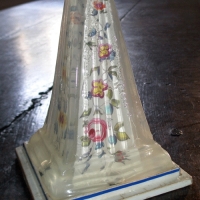 Two Part Cream Creamware made by Wedgewood
Close
Two Part Cream Creamware made by Wedgewood
Close
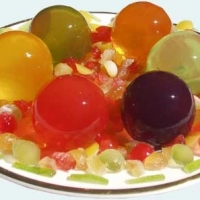 Sample of Ballatte or Bombe Molds
Close
Sample of Ballatte or Bombe Molds
Close
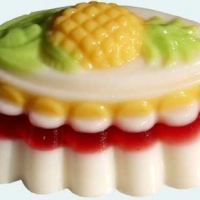 A panachee jelly topped by a pineapple crea
Close
A panachee jelly topped by a pineapple crea
Close
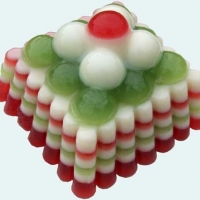 Russian Jelly (victorian Period)
Close
Russian Jelly (victorian Period)
Close
People Who Like This Dish 4
- angelica14 St Petersburg, FL
- tamfas Toronto
- andiecooks Home, My Place
- jeffsgirl Medford, OR
- hopscotch CA
- Show up here?Review or Bookmark it! ✔
The Rating
Reviewed by 3 people-
beautiful, just beautiful. who knew? i agree with brianna about the amount of time that went into the creation of a jelly all those years ago...and now...jello? it seems like sacrilege to those who put their blood sweat and tears into food preparatio...more
 andiecooks
in home loved it
andiecooks
in home loved it
-
I love this post. I find it so interesting to learn the history behind something that is so simple to us these days as jello. We just pour it from a package & add water. Can you just imagine the work that went into it those many years ago. Those pict...more
 brianna
in loved it
brianna
in loved it
The Groups
- Not added to any groups yet!
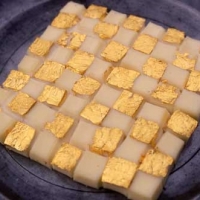
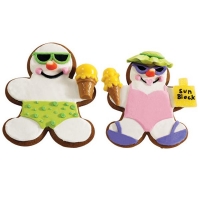
Reviews & Comments 3
-
All Comments
-
Your Comments
" It was excellent "
" It was excellent "